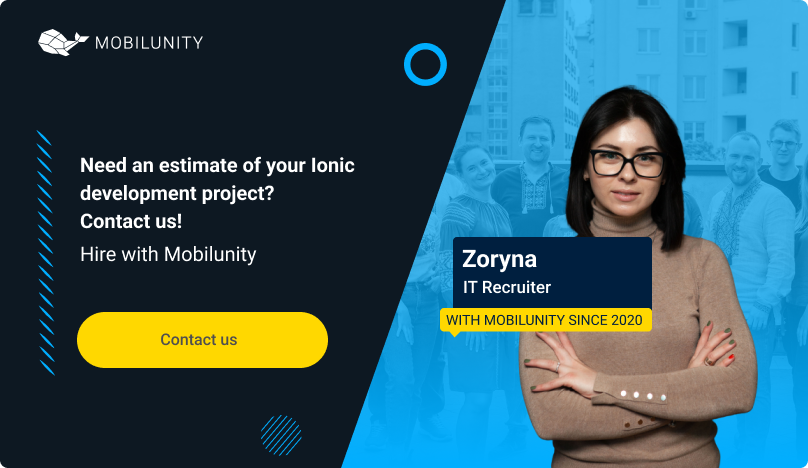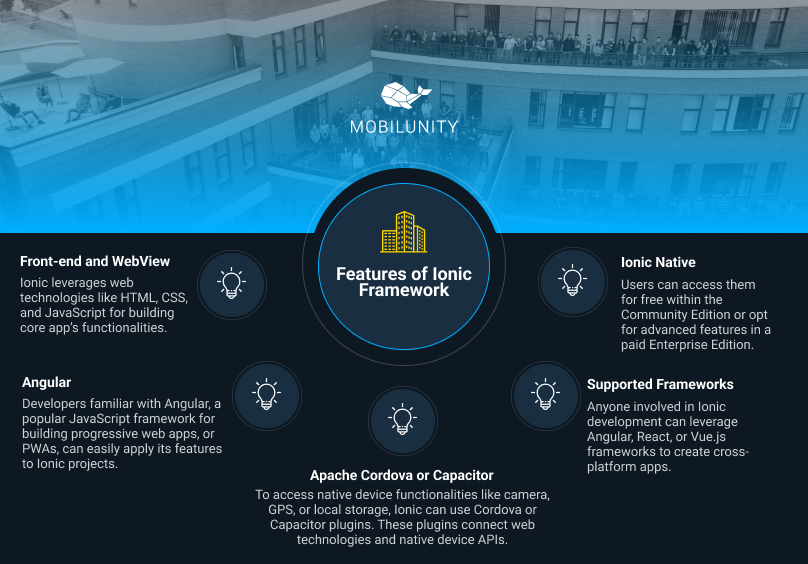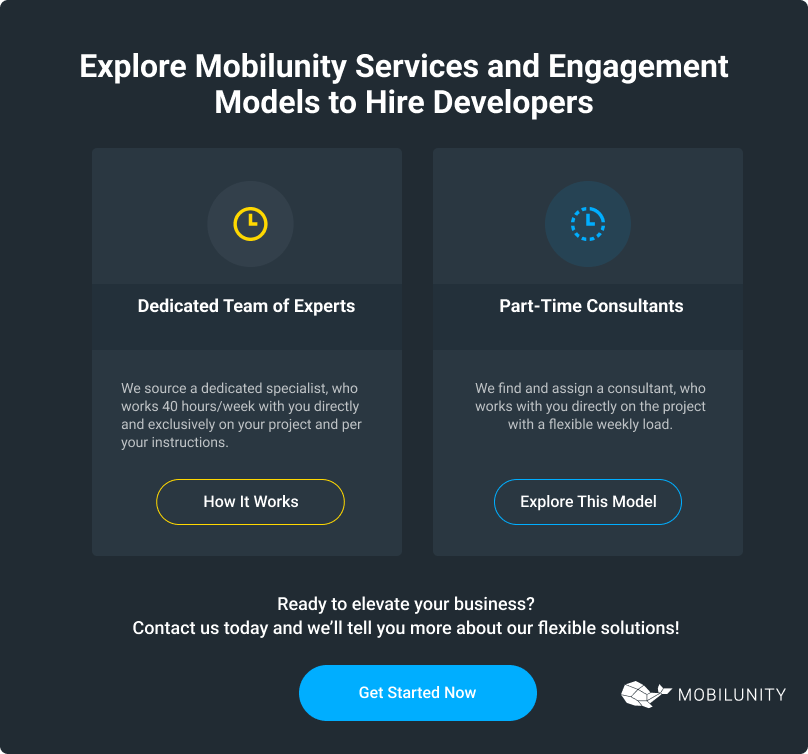How Much Does Ionic App Development Cost?

Imagine this: you’re building a mobile app. Native development for iOS and Android seems perfect — top performance, advanced features. But then reality hits. Double the development cost and double the efforts with separate codebases and teams.
Luckily, there’s a solution. Choose cross-platform development instead. Tools like Ionic let you build apps with near-native performance and a single codebase for both Android and iOS. This cuts development costs dramatically. While you’ll still need to hire Ionic developers for a quality application, this framework might be your way to a robust, cost-effective mobile solution.
Ranked third for cross-platform app development globally, Ionic brags an 11% developer adoption rate. Today, we’ll discuss this popular framework in greater detail, covering Ionic app development cost, price-influencing factors, and devs’ salaries.
Overview of Ionic Framework
Released in 2013, Ionic is an open-source framework for building cross-platform apps. It lets you code once in HTML, CSS, and JavaScript (or TypeScript) and then turn your code into iOS, Android, desktop, and progressive web applications. It also comes with a library of platform-specific UI elements, so your app looks natively on any device.
Features of Ionic Framework
The Ionic framework offers the following distinctive features:
- Front-end techs and WebView. Ionic leverages web technologies like HTML, CSS, and JavaScript for building core app’s functionalities. These are then displayed within a device’s WebView, creating a native-like experience.
- Angular. Ionic uses Angular’s components and a command-line interface to simplify the app development process. Developers familiar with Angular, a popular JavaScript framework for building progressive web apps, or PWAs, can easily apply its features to Ionic projects.
- Apache Cordova or Capacitor plugins. To access native device functionalities like camera, GPS, or local storage, Ionic can use Cordova or Capacitor plugins. These plugins connect web technologies and native device APIs.
- Supported frameworks. Anyone involved in Ionic development can leverage Angular, React, or Vue.js frameworks to create cross-platform apps.
- Ionic Native. Ionic Native is a library of native Cordova and Capacitor plugins. Users can access them for free within the Community Edition or opt for advanced features in a paid Enterprise Edition.
Benefits of Ionic Framework
Using Ionic for cross-platform development brings a lot of advantages:
- Unified codebase. With Ionic, you can write your code once and run it everywhere. Owing to that, you reduce development time and cost, speed up time-to-market, and simplify app maintenance and bug fixes.
- Familiar technologies. Ionic lets you use popular languages like HTML, CSS, and JavaScript and frameworks like Angular, React, and Vue.js for development. These techs are relatively easy to learn and have a strong community.
- Numerous plugins. Extend your app’s functionality with a vast library of plugins. Integrate camera access, payment solutions, and more by getting the relevant tools from the official Ionic website.
- UI components. Ionic allows you to leverage an extensive collection of pre-designed UI elements. These adapt to the target platform, whether iOS or Android, ensuring a native look and feel.
- Simple testing. As long as your app operates within WebView, you can test it right through your browser. Leverage Angular CLI and Ionic CLI to check Angular and web components, respectively.
- Clear documentation. When handling custom mobile app development, clear and concise Ionic documentation is undoubtedly a benefit. It lets you get started more easily and find appropriate solutions.
- Active community. Ionic has a large and active community of developers who share practical insights and might have answers to your questions.
Use Cases of Ionic Framework
Ionic suits various app types, but the perfect use cases include:
- eCommerce apps. Devs can create high-performing mobile shopping applications with Ionic.
- SaaS apps. Ionic is perfect for SaaS application development, given the numerous plugins available.
- Social networking apps. Ionic’s capability to handle dynamic content makes it ideal for social networking platforms.
- Enterprise apps. Ionic is well-suited for corporate settings, where data visualization and workflow management are important.
Key Factors Affecting Ionic App Development Cost
Ionic programming is certainly more cost-effective than native development. However, your cross-platform app’s final price may vary based on several factors. Let’s discuss them in greater depth.
Project Complexity
The complexity of your app directly impacts development time and cost. Here’s what to consider:
- Features and functionality. Simple apps with basic features like static content and minimal user interaction require less development effort than applications with complex functionalities like real-time chat, advanced security, or complex data processing.
- Customization level. Highly customized apps with unique UI elements or bespoke functionalities demand more development time compared to those that use ready-made Ionic components.
Design Requirements
A well-designed app must not only look good but also deliver a smooth user experience. To achieve such a result, you should consider the following aspects that can affect cost:
- UI complexity. Simple, clean UI designs are easier to implement than those with high levels of customization, animations, or user interactions.
- UX complexity. A decent user experience can only be achieved through extensive research, which impacts the final cost.
- Number of screens. The number of screens your app has will influence design and development time. More screens mean a potentially higher cost.
- Prototyping and wireframes. If you want to test your app before launch, you may require basic prototypes and wireframes that demand additional investment.
- Branding. Custom design and branding require extra time and work, so they impact the final price as well.
Development Team
The composition and expertise of your development team significantly impact the overall cost:
- Team structure. Team structure. Building an in-house team requires significant upfront costs for salaries, equipment, and workspace. Opting for freelance or outsourced devs, such as hire dedicated iOS developers, is usually a more cost-effective option, but managing them remotely requires additional effort.
- Developer experience. Highly experienced Ionic developers demand a higher hourly rate compared to less experienced ones.
- Team location. Developer rates vary depending on geographic location. Think of Eastern Europe and South America as cost-effective options and North America and Western Europe — more expensive ones.
Third-Party Integrations
Integrating with third-party services and APIs can improve your app’s functionality, but it can also impact costs. Most APIs have usage fees, which add to your ongoing expenses. Implementing these third-party solutions also requires additional development time, meaning more costs involved.
App Maintenance and Support
The work on your app doesn’t end after the launch. Here are some post-launch expenses to consider:
- Bug Fixes and Updates. Maintaining your app with bug fixes, security updates, and new feature integrations needs continuous development effort.
- App Store Fees. Apple App Store and Google Play Store charge fees for app submission and in-app purchases.
Estimating Your Ionic App Development Cost
Having learned the cost-influencing factors, let’s now see how to estimate the budget for your Ionic project.
Step-by-Step Breakdown
To build cross platform apps on Ionic, you should go through several stages, each with its timeline and costs. Here’s the breakdown of typical project phases:
- Planning. It involves defining the app’s concept, features, target audience, and user journey. It usually takes from one to two weeks.
- Design. It covers UI and UX design, wireframe and prototype creation, graphic design, and branding. This stage may take from six to twelve weeks.
- Development. It involves front-end development, back-end development, and third-party services/API integration. It typically lasts from six to twelve weeks.
- Testing. It includes manual and potentially automated testing to ensure your app functions properly. This stage’s duration differs following the project’s scale and may be handled simultaneously with development.
- Deployment. It involves launching your app on the Apple App Store and Google Play Store. This takes up to two weeks.
Tools for Cost Estimation
To simplify your Ionic coding cost calculation, try some tools and services. Here are just several options at your disposal:
- Online app cost calculators. Leverage tools like Oozou or BuildFire to estimate your app price following project specifications like features, platforms, and integrations.
- Hourly, monthly, and yearly developer rates. Check out the Ionic developer salary in your preferred location. Consider the rates for other specialists within your team, including designers, QA specialists, and so on.
- Dev agency consultation. Reach out to a software development company like Mobilunity and state your project requirements to get a more precise estimation.
Reducing Ionic App Development Costs
If the estimated price of your app goes beyond your budget, don’t panic. We’ve prepared several tips that will help you optimize your Ionic app development cost.
Choosing the Right Development Team
Find the right dev team right from the beginning. Make sure that the chosen experts can deliver a high-quality Ionic JS application within your budget by evaluating the following:
- Experience with Ionic. Look for a team with proven expertise in Ionic development.
- Expertise in associated technologies. Check if your team has a solid knowledge of HTML, CSS, JavaScript, and tools like Angular, Cordova, and others.
- Clear communication. Ensure the development team communicates transparently and uses effective project management methodologies.
- Location. Explore development teams from regions with lower labor costs if you aim for cost savings.
- Cooperation model. Choose a suitable cooperation approach. Dedicated teams are usually more expensive than, for example, part-time specialists.
Pre-Built Ionic Components, Plugins, and Beyond
Other means to optimize your budget involve using ready-made UI components and plugins by Ionic. They let you:
- Reduce design time by leveraging pre-build common UI elements like buttons or menus.
- Extend your app’s functionality through plugins without building custom (and usually costly) features from scratch.
Speaking of features, focus on the most critical ones. Don’t try to pack everything into the initial app launch. Start from minimum viable product development and roll out additional functionalities following user feedback and future iterations.
Recruiting Ionic Development Team
Building a well-coordinated team for Ionic web or mobile development requires some effort from your side. Here’s what to look for in your ideal candidate:
- Technical skills: Ionic, HTML, CSS, JavaScript, TypeScript, Angular, React, Vue.js, Apache Cordova, Capacitor.
- Soft skills: effective communication, teamwork, problem-solving, passion for creating user-centered apps.
The talent pool for Ionic developers is growing globally. Look at the availability of such specialists in different countries according to LinkedIn:
| Country | Number of Ionic Developers |
| The USA | 1,810,000 |
| The UK | 311,000 |
| Germany | 212,000 |
| Ukraine | 62,000 |
| Poland | 100,000 |
| Romania | 59,000 |
| Georgia | 8,100 |
| Azerbaijan | 4,600 |
| Armenia | 9,100 |
| Uzbekistan | 4,600 |
| Kazakhstan | 10,000 |
| Bulgaria | 19,000 |
| Moldova | 3,500 |
As you can see from the table, Eastern Europe offers an immense pool of Ionic developers — a cost-effective option for building your app. Even better, Mobilunity can hire locally in all the Eastern European countries listed above.
Ionic App Development: What’s the Cost?
As mentioned earlier, technical and soft skills, location, and expertise impact the Ionic developer’s salary. Let’s now look at the rates of such specialists in different countries.
As the table shows, Ionic development rates greatly differ depending on location. Eastern European countries like Ukraine offer a significant cost advantage and a large pool of highly qualified Ionic specialists.
Go Cross-Platform with Mobilunity
Mobilunity is a leading provider of Ionic consulting services in Ukraine. We offer an extensive pool of Ukrainian developers, with Junior alongside Senior specialists. To leverage Ionic for web and mobile, access offshore Node JS development, or work on any other project, choose between the following two cooperation approaches:
- Dedicated teams of experts. Ideal for large-scale, complex Ionic app development projects.
- Part-time consultants. Perfect for smaller projects, short-term needs, or situations with lighter development workloads.
Join our happy clients across different industries, including eCommerce, media, FinTech, SaaS, and beyond. Create performant solutions with us, just like we did for XPLG, 42Matters, and Byg-e.
Want to know the precise Ionic app development cost? Reach out to Mobilunity experts and get accurate estimations for your project!
Disclaimer: All salaries and prices mentioned within the article are approximate NET numbers based on the research done by our in-house Recruitment Team. Please use these numbers as a guide for comparison purposes only and feel free to use the contact form to inquire on the specific cost of the talent according to your vacancy requirements and chosen model of engagement.








